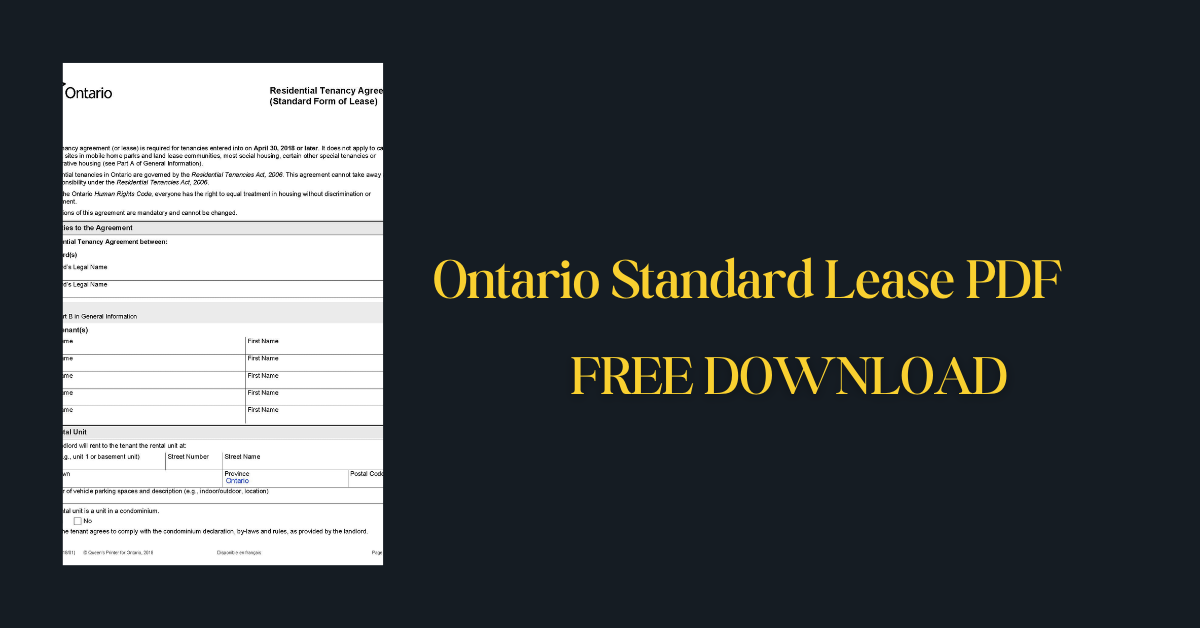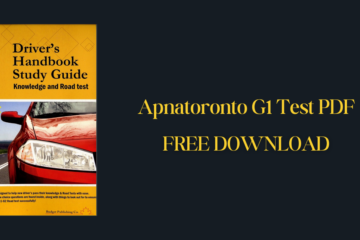The Ontario Standard Lease is a mandatory lease agreement for most residential tenancies in Ontario, Canada. It’s designed to make rental agreements clearer and protect both landlords and tenants under the Residential Tenancies Act, 2006.
The standard lease must be used for most residential tenancies signed on or after April 30, 2018, including single and semi-detached houses, apartment buildings, rented condominiums, and secondary units (like basement apartments).
| Name of the PDF | ontario standard lease pdf |
| No. of pages | 15 |
| Category | |
| Language | English |
| PDF Link | Click Here |
Also Download
What is the Ontario Standard Lease
The Ontario Standard Lease is a mandatory lease agreement for most residential rental properties in Ontario, Canada. Introduced by the Ontario government, this form is designed to standardize rental agreements across the province, making it easier for both landlords and tenants to understand their rights and responsibilities.
The Standard Lease applies to various types of residential properties, including apartments, houses, and secondary units like basement apartments.
Key features of the Ontario Standard Lease include:
- Comprehensive Details: It covers terms and conditions of the tenancy, including rent details, services included, rules about the use of property, and more.
- Mandatory Use: Most residential landlords in Ontario must use this form for leases signed on or after April 30, 2018. It’s required for single and semi-detached houses, apartment buildings, rented condominiums, and secondary units.
- Clear Language: The lease is designed to be easy to understand, using plain language to describe the rights and responsibilities of landlords and tenants.
- Standardization: By standardizing the lease agreement, the Ontario government aims to reduce disputes between landlords and tenants, as the terms are clearly laid out and agreed upon by both parties.
- Modifications and Additions: While the main body of the Standard Lease cannot be altered, landlords and tenants can agree to additional terms that can be attached to the lease if they do not conflict with the standard terms or violate the Residential Tenancies Act.
The Ontario Standard Lease aims to protect both landlords and tenants by ensuring that all parties have a clear, mutual understanding of their agreement from the outset of the tenancy. This form helps to prevent misunderstandings and provides a legal framework for resolving disputes should they arise.
Significance of the Ontario Standard Lease
The Ontario Standard Lease holds significant importance in the residential rental market for several reasons, benefiting both landlords and tenants by ensuring clarity, consistency, and fairness in rental agreements. Here are some key aspects of its significance:
Legal Clarity and Protection: The Standard Lease clearly outlines the rights and responsibilities of both parties, reducing misunderstandings and potential disputes. It provides a legal framework that both landlords and tenants can refer to, which is especially important in resolving conflicts or when seeking remedies through the Landlord and Tenant Board.
Standardization Across the Province: Prior to the introduction of the Standard Lease, rental agreements could vary widely, with some lacking essential information. This standardization ensures that all parties have the same baseline information and are aware of their obligations and rights under the Residential Tenancies Act.
Enhanced Security for Tenants: Tenants benefit from the Standard Lease’s clear terms regarding rent, services included, rules about the use of property, and termination. This transparency helps tenants understand exactly what they are agreeing to, providing them with a sense of security and stability.
Fairness and Balance: The Standard Lease is designed to be fair, balancing the interests of both landlords and tenants. It prevents the inclusion of illegal clauses that some landlords might have added to custom lease agreements, ensuring that all terms comply with the Residential Tenancies Act.
Simplification of the Leasing Process: By using a uniform document, the process of drafting and signing lease agreements is simplified for landlords, saving time and reducing the need for legal consultation to prepare compliant leases.
Promotion of Better Landlord-Tenant Relationships: Clear communication and understanding are foundational to good landlord-tenant relationships. The Standard Lease facilitates this by clearly setting expectations from the beginning, reducing the likelihood of disputes and fostering a more positive relationship between the parties.
Educational Tool: For many tenants and first-time landlords, the Standard Lease acts as an educational tool, informing them of their legal rights and responsibilities. This awareness can lead to more respectful and law-abiding tenancies.
Adaptability with Addendums: While the main body of the Standard Lease cannot be modified, landlords and tenants can attach schedules of additional terms, provided these do not contravene the Standard Lease terms or the Residential Tenancies Act. This flexibility allows for the accommodation of specific needs and agreements between the parties.
Who Is Covered by the Ontario Standard Lease
The Ontario Standard Lease is designed to cover most residential tenancies in Ontario, Canada. However, there are specific types of tenancies and accommodations that are included under its umbrella, as well as some exceptions. Here’s a breakdown:
Covered by the Ontario Standard Lease:
- Single and Semi-Detached Houses: These are typical residential homes intended for one or multiple tenants.
- Apartment Buildings: Standard multi-unit residential buildings fall under this category.
- Condominiums: Rented condominium units are included, regardless of the building’s size or type.
- Secondary Units: This includes basement apartments or other secondary units that are part of a principal residence, provided they are not shared with the owner.
Not Covered by the Ontario Standard Lease:
Certain living arrangements and types of properties are exempt from the requirement to use the Ontario Standard Lease, including:
- Social and Supportive Housing: Housing provided by municipalities or deemed non-profit, where other Acts may apply, such as the Housing Services Act.
- Co-operative Housing: Tenancies within co-operative housing are governed by their own rules and agreements, typically not requiring a standard lease.
- Commercial Properties: The Standard Lease applies only to residential tenancies, so commercial leases are not included.
- Transient Living: Accommodations meant for transient use, such as hotels, motels, and some forms of short-term rentals, do not require a Standard Lease.
- Student Residences: Accommodations provided directly by educational institutions to their students might not require the Standard Lease.
- Care Homes: This includes residences like retirement homes or nursing homes where the tenancy includes care services beyond just accommodation.
- Leases Signed Before April 30, 2018: Tenancies that were established with a lease agreement signed before the Standard Lease became mandatory on April 30, 2018, are not required to retrospectively adopt it unless a new lease agreement is signed.
It’s important for both landlords and tenants to understand whether their tenancy falls under the jurisdiction of the Ontario Standard Lease to ensure compliance with provincial laws and regulations. For tenancies that are covered, using the Standard Lease is mandatory and provides legal protection and clarity for both parties.
Advantages of Using the Ontario Standard Lease
The Ontario Standard Lease offers numerous advantages for both landlords and tenants, contributing to a more transparent, fair, and straightforward rental market in Ontario. These benefits help to improve the overall rental experience by ensuring that all parties have a clear understanding of their rights and responsibilities. Here are some of the key advantages:
For Both Landlords and Tenants
- Clarity and Consistency: The Standard Lease uses clear language to outline the rights and responsibilities of both parties, reducing misunderstandings and the potential for disputes.
- Legal Protection: It ensures that lease agreements comply with the Residential Tenancies Act, 2006 (RTA), protecting both parties from illegal terms and conditions.
- Standardization: A uniform lease agreement across Ontario simplifies the rental process, making it easier for landlords to prepare agreements and for tenants to understand their tenancy terms, regardless of where they are renting in the province.
- Dispute Resolution: By clearly outlining the terms of the tenancy, the Standard Lease can serve as a reference in resolving disputes, potentially avoiding the need for litigation or intervention by the Landlord and Tenant Board.
For Tenants
- Awareness of Rights: The Standard Lease educates tenants about their rights under the RTA, which they might not be aware of otherwise. This knowledge can empower tenants to advocate for themselves in tenancies.
- Security and Stability: Knowing exactly what is included in the rent, the rules around rent increases, and the conditions for termination gives tenants a sense of security and stability.
- Avoidance of Illegal Clauses: The Standard Lease prevents landlords from including illegal clauses that might limit tenants’ rights, such as forbidding pets (with certain exceptions) or requiring post-dated cheques.
For Landlords
- Efficiency: Using a government-provided template saves landlords time and resources in drafting lease agreements and ensures that they do not inadvertently include unenforceable terms.
- Reduced Legal Risks: Compliance with the RTA through the Standard Lease minimizes the risk of legal challenges from tenants regarding unfair or illegal lease terms.
- Clarity on Additional Terms: While the main body of the lease is standardized, landlords can still attach additional terms (e.g., conditions regarding smoking or maintenance responsibilities) as long as they do not contradict the Standard Lease or the RTA, offering some flexibility to address specific concerns.
How to Obtain the Ontario Standard Lease
Obtaining the Ontario Standard Lease is a straightforward process, designed to ensure that landlords and tenants have easy access to this important document. Here are the steps and resources available to secure a copy of the Ontario Standard Lease:
Online from the Ontario Government Website
The Ontario Standard Lease template is available for free on the official website of the Government of Ontario. It can be downloaded as a PDF or an editable Word document. This is the most direct and reliable source for obtaining the lease, ensuring you have the most current version.
From Landlords
Landlords are required to provide the Standard Lease to their tenants for most residential tenancies. If a tenant requests a lease and the landlord fails to provide it within 21 days, the tenant can withhold one month’s rent. Additionally, if the landlord still doesn’t provide the lease within 30 days after the rent was withheld, the tenant does not have to repay the withheld rent. However, it’s always best for tenants to remind their landlords about this obligation if a lease hasn’t been provided.
Real Estate Agents and Legal Services
Real estate agents who are helping clients to find rental properties or legal professionals familiar with residential tenancies may also be able to provide copies of the Ontario Standard Lease. They can offer assistance in understanding and completing the lease agreement properly.
Tenant Associations and Community Legal Clinics
Tenant associations and community legal clinics often have resources available for renters, including access to standard lease forms and guidance on how to complete them. These organizations can also offer support and advice on tenants’ rights and responsibilities under the lease.
Property Management Companies
If you’re renting in a building managed by a property management company, they will typically use the Ontario Standard Lease for all their rental agreements. They can provide tenants with a copy when discussing rental terms.
How to Fill the Ontario Standard Lease
Filling out the Ontario Standard Lease involves completing several sections with specific details about the rental agreement between the landlord and tenant. Here’s a step-by-step guide on how to properly fill out the lease:
Rental Unit Information
- Address of the Rental Unit: Include the full address of the property being rented.
- Type of Rental Unit: Indicate whether it’s an apartment, house, room, etc.
Parties to the Lease
- Landlord(s) Information: Full legal name(s), addresses, and contact information.
- Tenant(s) Information: Full legal name(s) of all tenants who will be living in the rental unit and their contact information.
Term of the Lease
- Lease Duration: Specify whether it’s a fixed-term lease (e.g., one year) or a month-to-month arrangement. Include the start date and, if applicable, the end date.
Rent Details
- Monthly Rent Amount: The total amount of rent due each month.
- Rent Due Date: The day of the month by which rent must be paid.
- Method of Rent Payment: How the rent will be paid (e.g., check, electronic transfer).
- Rent Deposit: If a rent deposit is required, include the amount (note: it cannot be more than one month’s rent for a monthly rental or one week for a weekly rental).
- Services Included: Clearly indicate which utilities and services (e.g., water, heat, electricity) are included in the rent.
Additional Terms
- Optional for Landlord and Tenant: This section can be used to agree on additional terms not covered by the standard lease, such as conditions for pets, smoking, or use of common spaces. Any additional terms must not contradict the standard lease or violate the Residential Tenancies Act.
Signatures
- Landlord’s Signature: The landlord(s) must sign and date the lease.
- Tenant’s Signature: All tenants must sign and date the lease, indicating their agreement to its terms.
Tips for Filling Out the Lease
- Be Detailed and Specific: Ensure that all information provided is accurate and specific to avoid misunderstandings.
- Review the Standard Lease Guide: The Ontario government provides a guide alongside the lease template, offering explanations and instructions for each section. Reviewing this guide can help ensure that you understand all aspects of the lease.
- Check for Compliance: Make sure that any additional terms added to the lease comply with the Residential Tenancies Act and do not infringe on the rights of either party.
- Consult if Unsure: If there’s any uncertainty about how to fill out certain sections or what terms to include, consider seeking advice from a legal professional or a tenant advocacy group.
Once the lease is fully completed and signed by all parties, both the landlord and tenants should keep a copy for their records. This document will serve as the official agreement for the tenancy and can be referred to in case of any disputes or questions about the terms of the rental arrangement.
Conclusion
With its uniform framework for residential tenancy agreements, the Ontario Standard Lease is a useful tool for both landlords and tenants in Ontario. By using the standard lease, both parties can ensure clarity, fairness, and compliance with provincial tenancy laws.
Knowing the terms of the Ontario Standard Lease can help you safeguard your rights as a tenant or landlord and ensure that your renting experience is enjoyable.
FAQs
Does Ontario have a standard lease?
Yes, Ontario mandates the use of a Standard Form of Lease for most private residential rental units. This became mandatory for any new tenancies signed on or after March 1st, 2021. Landlords are legally obligated to use this standardized form, and you can access it through the Ontario government website.
What happens if a landlord does not use the Ontario Standard lease?
If a landlord does not use the Ontario Standard Lease, the tenant has the right to request it in writing. The landlord then has 21 days to provide the standard form. In the case that the landlord fails to do so, the tenant has the right to withhold one month’s rent. While a tenancy agreement might still be valid without the standard lease, it creates complications for both parties in clarifying their rights and responsibilities under the Residential Tenancies Act.
Who fills out the Ontario Standard Lease?
Both the landlord and the tenant are responsible for filling out and signing the Ontario Standard Lease. It’s a contract, so both parties need to agree to and sign off on the terms contained within it.
How long are leases in Ontario?
Leases in Ontario can either be fixed-term (with a set end date, for example, one year), or they can be month-to-month (with no fixed end date). Importantly, Ontario does not have a maximum length for a fixed-term lease.
What happens after a 1-year lease is up in Ontario?
After a one-year lease expires in Ontario, it automatically transitions into a month-to-month tenancy. This process continues unless the landlord and tenant agree to sign a new fixed-term lease or the tenant provides notice to vacate the rental unit.
Can you break a 1-year lease in Ontario?
Yes, it is possible to break a fixed-term lease in Ontario, but there are limitations. A tenant can provide 60 days’ notice to terminate the tenancy early. Landlords, on the other hand, can only terminate a tenancy agreement early under specific circumstances explicitly outlined in the Residential Tenancies Act. Some examples of valid reasons for landlord termination include the tenant repeatedly violating lease terms or the landlord intending to demolish or repurpose the unit.
Can you rent without a lease in Ontario?
Technically, yes, you can rent in Ontario with a verbal rental agreement instead of a written lease. However, this is strongly discouraged. Without a written document, it becomes incredibly difficult to prove the agreed-upon terms of your tenancy or to enforce your rights as either a tenant or a landlord if disagreements arise. A written lease provides clarity and protection for both parties involved.
Can I give 30 days’ notice in Ontario?
Generally, no. Ontario law requires a minimum of 60 days’ written notice when a tenant wishes to end a tenancy, regardless of whether the lease is a fixed-term or month-to-month.
Can a landlord break a lease in Ontario?
A landlord in Ontario can only break a lease under specific circumstances and with proper notice periods as outlined in the Residential Tenancies Act. Valid reasons might include the tenant significantly damaging the property, the landlord needing to use the unit for themselves or immediate family, or the landlord intending to demolish, convert, or repair the unit. Regardless of the reason, the landlord must follow legal procedures, including providing the tenant with sufficient notice.
When did the Ontario Standard Lease start?
Ontario started requiring the mandatory Standard Lease in 2018, with new tenancies signed after April 30th needing to use this form. The most up-to-date version of the form is from December 2020.

Niketa Mulay, a seasoned content writer and editor, has over a decade of experience. With a Master’s in Journalism, she honed her skills at The Times of India and now freelances across various industries. Passionate about reading, writing, and scuba diving, she shares expert PDF guides and tips at PDFdrivehub.com.




